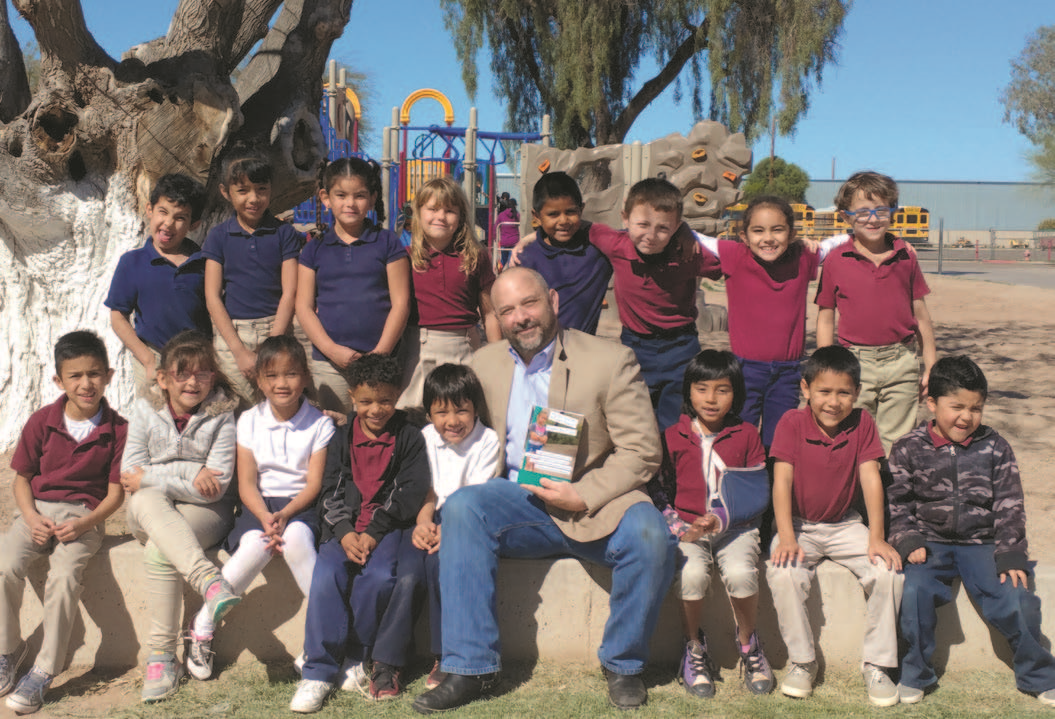Sections / Articles
Wellness: A School's Healthy Alternative
By LaGloria Wheatfall
Principal, September/October 2017. Vol. 97, Number 1.

At the young age of 36, Chris Lineberry, then a first-year principal in North Carolina, experienced sharp pains in his chest and jaw, accompanied by high blood pressure. It turned out to be a heart attack and was the shock of his life. The experience also motivated Lineberry, now principal of Stanfield Elementary in Arizona, to turn his pain into a plan—for a healthier lifestyle and school.
Not only does Lineberry credit the healthy focus to his life-changing experience, but with the help of what he describes as his “amazing” staff, he also created ways to help improve the overall health of the school. Lunch menu options were altered, as unhealthy high-in-sugar foods were eliminated and replaced with nutritious alternatives. In addition, the principal made recess mandatory, and a daily hour of physical activity was required for both students and teachers.
An unfortunate result of recent emphasis on grades and testing, says Lineberry, is that “we’ve gotten away from seeing the whole child.” But, he adds, “Research is on our side, and it says healthy, active kids perform better and live longer.”
The now healthy and energetic principal stresses why it is important for all schools to implement physical activity and health and wellness within the curriculum every day to help combat child obesity and improve learning. Lineberry talked with Principal about how he continues to advocate for students to have a healthy school environment in order to be productive, efficient lifelong learners.
On the early-career health scare that sparked a health-and-wellness movement:
In January 2006 I was working as a principal at Richfield Elementary School in Stanly County, North Carolina. We had an incident with a child who was being abused by someone related to her, and it bothered me terribly. This was a pre-K student. At about 1 p.m. the child really started acting out and crying; she was in pain and needed help. We had social services and medical get involved, as well as law enforcement, and she was taken care of. At about 4 p.m. I still didn’t feel right, as I was having some chest pain, and my jaw was bothering me. I called one of the paraprofessionals, who also worked for the volunteer fire department, and asked her if she wouldn’t mind taking my blood pressure. My BP was 157/109. I was taken to the hospital in an ambulance from my school. I was having a heart attack at age 36.
On the school’s health-and-wellness curriculum:
I believe health and wellness are as essential a component of the curriculum as reading and math. The challenge is to find time without adding time. This is where content integration is key. By tearing down interdisciplinary walls and integrating content, we make learning more meaningful. At Stanfield Elementary here in Arizona, we have PE for every student every day, and it is forbidden to use recess—taking it away—as a form of punishment.

On his biggest challenge:
There are multiple challenges to implementing change in any setting. Change is difficult, especially in education. Here at Stanfield, we are no different. One of the things that we have done is really worked to identify and embrace our “why.” We have to have a big why, because the resistance to change and challenging the status quo is extremely powerful. My why, the why of Stanfield, is our students and community. So, change is a monumental challenge. Underneath that reluctance to change, quite honestly, in most cases is fear—fear of adverse effects on test scores, fear of loss of instructional time, fear of negative press or consequences. Research and science are our best defense against these fears; they show the connection to student achievement and longer lives.
On teacher/student reactions:
Our staff has been very receptive. Oftentimes the resistance to change in the cafeteria has a financial component to it, either that it is too expensive to provide healthy choices, or that profit will drop because kids won’t buy healthy options. We have found neither to be the case. Over 65 percent of our students eat breakfast at school every day, and over 96 percent of students eat our lunches. We provide tasty, healthy, and appetizing options on the same budget that every Title I school has.
How parents can help:
Parents are key—encouraging children to be active, to talk about what they have learned at school, to discuss nutrition with them, and to learn with them about making healthy choices. There is no magic bullet to better health; there are multiple areas of focus, from nutrition, sleep, physical activity, and exercise to health education and being health-literate that all combine to promote a healthy lifestyle.
LaGloria Wheatfall is the digital communications associate at NAESP.
Get Your School Healthy:
Want to make healthy choices at your school? Start with these four steps.
Establish a school health advisory council to help implement healthy changes and seek local partnerships.
Alternate recess before lunch and after lunch to allow students to eat food at a digestible pace and to reduce throwaway food.
Create a flexible schedule for recess by evaluating the students’ energy levels to determine what time to take a break to help regain focus.
Incorporate physical activity breaks throughout the day, and also during teaching instruction to help increase student engagement and ensure active class participation. —LW
Copyright © National Association of Elementary School Principals. No part of the articles in NAESP magazines, newsletters, or website may be reproduced in any medium without the permission of the National Association of Elementary School Principals. For more information, view NAESP's reprint policy
| Attachment | Size |
|---|---|
| Wheatfall_SO17.pdf | 598.21 KB |